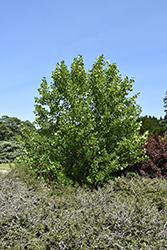It's all about ...
plants

Little Volunteer Tuliptree
Liriodendron tulipifera 'Little Volunteer'
Height: 20 feet
Spread: 12 feet
Sunlight:
![]()
Hardiness Zone: 5a
Other Names: Tulip Magnolia, Yellow Poplar, Whitewood
Description:
A neat and tidy, rounded selection featuring uniquely shaped leaves and large greenish-yellow tulip-shaped flowers with streaks of orange; needs lots of moisture, a good choice for a smaller landscape
Ornamental Features
Little Volunteer Tuliptree has buttery yellow cup-shaped flowers with yellow eyes and orange centers held atop the branches from mid to late spring. It has emerald green deciduous foliage. The square leaves turn outstanding shades of gold and yellow in the fall. The furrowed gray bark is extremely showy and adds significant winter interest.
Landscape Attributes
Little Volunteer Tuliptree is a deciduous tree with a strong central leader and a shapely oval form. Its average texture blends into the landscape, but can be balanced by one or two finer or coarser trees or shrubs for an effective composition.
This is a high maintenance tree that will require regular care and upkeep, and is best pruned in late winter once the threat of extreme cold has passed. Deer don't particularly care for this plant and will usually leave it alone in favor of tastier treats. Gardeners should be aware of the following characteristic(s) that may warrant special consideration;
- Insects
- Disease
Little Volunteer Tuliptree is recommended for the following landscape applications;
- Shade
- Vertical Accent
Planting & Growing
Little Volunteer Tuliptree will grow to be about 20 feet tall at maturity, with a spread of 12 feet. It has a low canopy with a typical clearance of 4 feet from the ground, and is suitable for planting under power lines. It grows at a fast rate, and under ideal conditions can be expected to live to a ripe old age of 100 years or more; think of this as a heritage tree for future generations!
This tree should only be grown in full sunlight. It prefers to grow in average to moist conditions, and shouldn't be allowed to dry out. It is not particular as to soil pH, but grows best in rich soils. It is quite intolerant of urban pollution, therefore inner city or urban streetside plantings are best avoided. This is a selection of a native North American species.
This plant is not reliably hardy in our region, and certain restrictions may apply; contact the store for more information.
